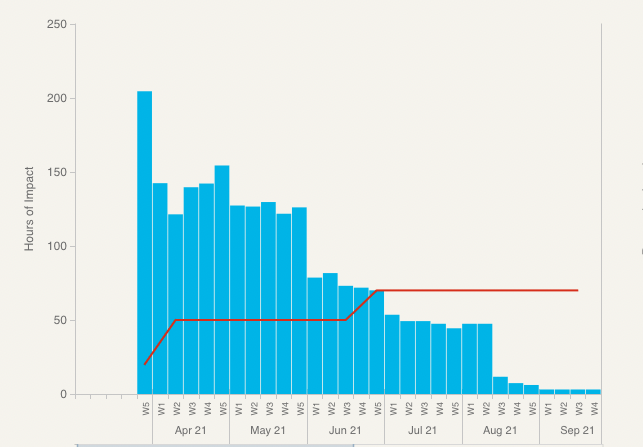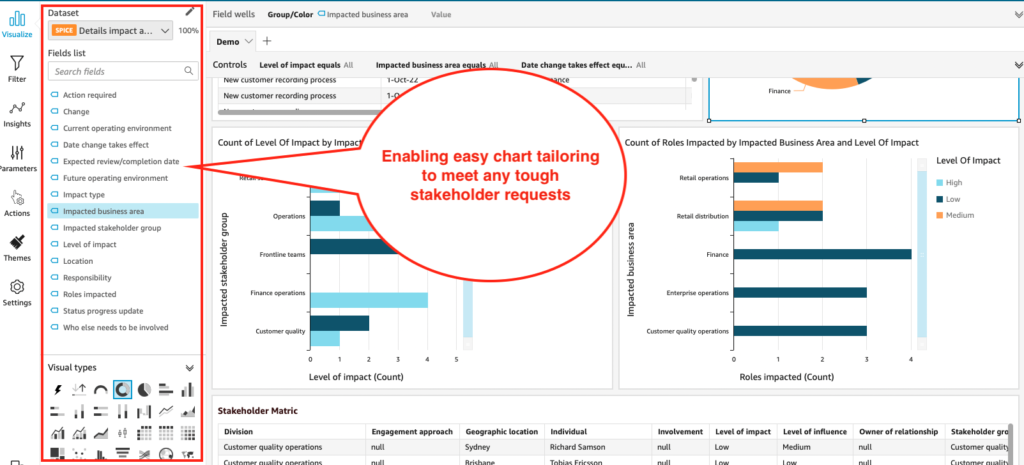Digitisation, Covid, competition and changing industry conditions have amongst other things brought on an accelerated change agenda for a lot of organisations. What were previously thought to be 1 to 5 year horizons of change suddenly became an immediate change. Not only is working from home a norm for a lot of organisations but the struggle for enterprises to survive and stay relevant in the new norm means more changes. The normal equilibrium for a lot of these organisations is one that consumes a smaller number of changes at any one time. Suddenly, with the increased number of changes this leads to change saturation.
Think of change saturation as a cup that fills up. The size of the cup is the change capacity. With limited capacity, there is only so much volume that is inherent. When the cup overflows the changes don’t stick and simply fall by the waist side.
What impacts an organisation’s change capacity?
1.Change leadership
Leaders can have significant influence on the organisation. Also, change leadership is a significant part of how change is managed and delivered. Effective change leadership can build on the capability of teams to be more agile and capable of absorbing more changes. Effective change leadership can also help to maximise how optimal the change is socialised and implemented, and therefore how it lands.
2. Change capability
The organisation’s change capability is one of the most important factors in determining their change capacity. Think of agile startup organisations that are constantly pivoting, introducing new operating models, products and services. This is part of their cultural norm. Other organisations that maybe less agile can also develop some of these capabilities through experience and development.
3. Nature of change
Not all types of changes are the same. Typically, a lot of the changes driven by senior leaders are about improving the bottom line or top line, improving customer experience or improving efficiency. Some are more complex changes requiring significant change journeys. Others may even be inherently ‘negatively perceived’ such as organisational restructuring and layoffs. However, there are also changes that are inherently seen as benefiting the work of employees (such as process improvement leading to less red tape).
4. Number of changes
The number of changes also impact the change capacity. Obviously more changes mean more capacity consumed, within an extent.
5. Impact of each change
The impact level of each change is also critical. Some initiatives have significant impact that requires a long period of time to embed the changes, e.g. culture change and complex system and process changes. On the other hand, simple process changes may not require much capacity and simple communication is all that is needed.
6. Overall change landscape
The overall change landscape of the organisation also affects perception and therefore in some ways the capacity for change. If competitors within the industry are all undergoing significant transformations then it sets the tone for what’s to come. In the same way, if all our friends are used to virtual ways of working then we become more open to it.

What’s the benefits of measuring change saturation?
Measuring change saturation can be significantly beneficial for the organisation. Understanding the tipping point means that PMO and change teams can work to avoid this from a planning perspective. Finding out during or after the releases that there is too much change saturation is an expensive exercise that diminishes the planned initiative benefits. It also leads to loss of productivity and operational disruptions. Moreover, employees lose faith in the ability of the organisation to manage change.
With greater clarity of the change saturation points organisations can work to monitor, track and manage the risk of over saturation. Measures can then be put in place to ensure minimal business disruption and protection of initiative benefits. This should be a key focus for risk in change.
How to measure change saturation?
Firstly, there is not one change saturation point for the whole organisation. Each department or even team may have different change saturation points. This is because they have different leaders, different cultural norms and different change capabilities.
So how do we measure the change saturation at a department or division level? Look historically at how changes have been received, starting with the past few months.
1. Monitor operational indicators
Depending on what the department is in charge of, understanding the change saturation point means closely monitoring the operational indicators. During change saturation operational indicators are usually also negatively impacted, depending on the nature of the changes.
For a call centre this could be average handling time, customer satisfaction rate, absenteeism, etc. For a back office department it could be efficiency or effectiveness measures, case completion rate, case quality rating, etc. You don’t need to be the expert in all the various operational measures of each department as you can tap on the operations representatives of these departments.
2. Get feedback from leaders
Interview or conduct surveys with departmental leaders to understand their perception of how changes have been implemented and any potential disruptions on the business. Understand how their teams have experienced change. Ask them whether it has been challenging to balance operational needs with change-induced activities. For example, were there challenges in employees attending initiative training sessions, and completing their role delivery obligations?
3. Be aware of potential biases
Be careful of opinions and feedback from leaders and employees. There may be a tendency to over-state and complain that there is constantly too much change. This happens because some over-state the risk of change saturation hoping that this may lead to less change and therefore easier to manage the operations of a business. Take care to avoid this bias.
4. Identify points of change saturation
If the department has undergone periods that has resulted in negative impact on operational indicators and leaders have also provided feedback of similar change disruptions then measure this level of change. Record this specifically.
This requires a portfolio-level view of all the changes that have occurred and the various impacts of each initiative. With this measurement you are able to then identify this level as perhaps just exceeding the change saturation point for that department. With this identified you can then plot this change saturation line. You should also closely monitor this level and adjust as needed.

Using The Change Compass change impact can be expressed in terms of hours of impact per week. The change saturation line can the plotted against the change impact levels. From this, you’re able to easily visualise to what extent there could be risk in exceeding the change saturation line.
It is important to note that measuring change impacts and therefore change saturation should ideally be at a weekly level. Measuring change impact at a monthly level may not be sufficiently detailed enough since there could be changes in impact levels within each month. For example, for Finance the quarter-end consolidation cycle could start mid-month and therefore the change impact indication may show up as less than it actually should be simply because the data is rolled-up by month.
Deriving a monthly dashboard in which to inform not just the change volume, but types of changes, risks, and impacted areas will do wonders to provide clear visibility for the business to get ready for and to track changes.

Other disciplines such as HR, Marketing or Operations rely on data to make critical business decisions. The Change function should also follow suit. Being armed with the right change impact data means that you can help the business to precisely pin-point change saturation points. This can provide tremendous value to the business in terms of business, initiative and risk protection.
If you’re keen to chat more about how you are managing change saturation and to find out more about our solutions feel free to contact us here to organise a chat.
Read more about 4 common assumptions about change saturation that is misleading.






